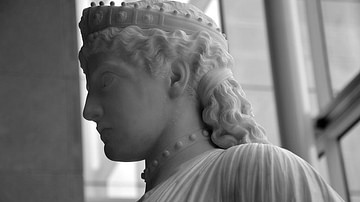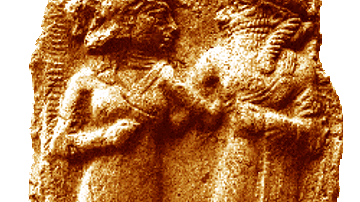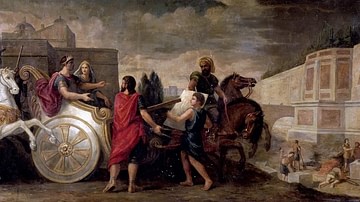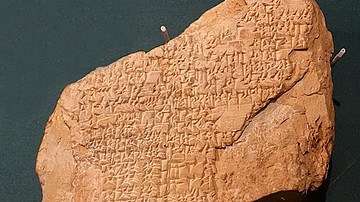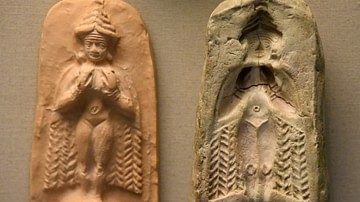Sammu-Ramat (r. 811-806 BCE) was the queen regent of the Assyrian Empire who held the throne for her young son Adad Nirari III (r. 811-783 BCE) until he reached maturity. She is also known as Shammuramat, Sammuramat, and, most notably, as Semiramis, the legendary and semi-divine super-heroine immortalized by later historians.
This last designation, "Semiramis", has been the source of considerable controversy for over a century now, as scholars and historians argue over whether Sammu-Ramat was the inspiration for the myths concerning Semiramis, whether Sammu-Ramat even ruled Assyria, and whether Semiramis ever existed as an actual historical personage.
The debate has been going on for some time and is not likely to be concluded one way or the other in the near future but, still, it seems possible to suggest the likely possibility that the legends of Semiramis were, in fact, inspired by the reign of queen Sammu-Ramat and have their basis, if not in her actual deeds, then at least in the impression she made upon the people of her time.
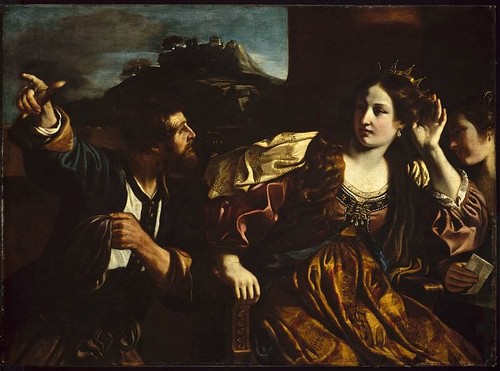
Shammu-Ramat was the wife of Shamshi-Adad V (r. 823-811 BCE) and, when he died, she assumed rule until Adad Nirari III came of age – at which time she passed the throne to him. According to historian Gwendolyn Leick, “This woman achieved remarkable fame and power in her lifetime and beyond. According to contemporary records, she had considerable influence at the Assyrian court” (155). This would explain how she was able to maintain the throne after her husband's death. Women were not admitted to positions of authority in the Assyrian Empire and to have a female monarch would have been unthinkable unless that particular woman had enough power to achieve it.
So impressive was her reign that, if one accepts her as the model for Semiramis, she would later be remembered by the Greeks, Assyrians, Armenians, and others as a semi-divine being who was born of the gods and raised by doves. The primary source for the tales concerning Semiramis is the Greek historian Diodorus Siculus (l. c. 90-30 BCE) who cited an earlier work by Ctesias (l. c. 5th century BCE) which is now lost, although she is also referenced by Herodotus and Strabo, and many legends concerning her have been preserved by other writers such as Polyaenus, Plutarch, Justinus, and Eusebius, among others.
A famous passage from Plutarch's Regum et Imperatorum Apophthegmata (Sayings of Kings and Commanders) relates:
Semiramis built a monument for herself, with this inscription: Whatever king wants treasure, if he open this tomb, he may be satisfied. Darius therefore opening it found no treasure, but another inscription of this import: If you were not a wicked person and of insatiable covetousness, you would not disturb the mansions of the dead. (4)
Eusebius references the Babylonian writer Berossus, complaining that the Greeks attributed to Semiramis great building projects she had no hand in, while Polyaenus references inscriptions of hers testifying to her exploits and the construction of “impregnable walls” of her cities.
Even before the time in which Diodorus wrote, Semiramis was associated with Ishtar/Inanna, Astarte, and divinity in general. She was revered by the Assyrians and reviled by the Armenians (possibly because of a successful military campaign she led against them) but was generally held in high regard until the coming of Christianity when she, like Ishtar, Aphrodite, Astarte, and the other ancient gods fell out of favor with the new faith.
She was made infamous in the 19th century by the book of anti-Catholic propaganda, The Two Babylons, by Christian minister Alexander Hislop who linked her to the Whore of Babylon in the Book of Revelation 17 (although she is never mentioned by name in Revelation, and no possible variation on her name is mentioned at all in the Bible negatively). While all of the above may be true, the identification of Sammu-Ramat with Semiramis has been repeatedly challenged since the late 19th century. Historians are divided on whether Sammu-Ramat ever ruled Assyria, whether her reign gave birth to the Semiramis figure, and whether she actually accomplished anything at all; because of this, and her identification with the biblical narrative in Revelation, she remains one of the more controversial figures from ancient history.
The Historical Reign of Sammu-Ramat
Shamshi-Adad V was the son of King Shalmaneser III (r. 859-824 BCE) and grandson of Ashurnasirpal II (r. 884-859 BCE). Their successful reigns and military campaigns would have provided Shamshi-Adad V with the stability and resources to begin his own successful reign had it not been for the rebellion of his older brother. Shalmaneser III's elder son, Ashur-danin-pal, apparently grew tired of waiting for the throne and launched a revolt against Shalmaneser III in 826 BCE. Shamshi-Adad V took his father's side and crushed the rebellion, but this took him six years to accomplish. By the time Ashur-danin-pal was defeated, much of the resources that Shamshi-Adad V would have had at his disposal were gone, and the Assyrian Empire was weakened and unstable.
It is at this time that Sammu-Ramat appears in the historical record. It is not known what year she married the king but, when her husband died and she took the throne, she was able to provide the nation with the stability it needed. Historians have speculated that, since the times seemed so uncertain to the people of Assyria, the successful reign of a woman would have engendered a kind of awe greater than that of a king because so unprecedented. She was powerful enough to have her own obelisk inscribed and placed in prominence in the city of Ashur. It read:
Stele of Sammuramat, queen of Shamshi-Adad, King of the Universe, King of Assyria, Mother of Adad Nirari, King of the Universe, King of Assyria, Daughter-in-Law of Shalmaneser, King of the Four Regions of the World.
What exactly Sammu-Ramat did during her reign is unknown, but it seems she initiated a number of building projects and may have personally led military campaigns. According to the historian Stephen Bertman, prior to Shamshi-Adad's death, Sammu-Ramat “took the extraordinary step of accompanying her husband on at least one military campaign, and she is prominently mentioned in royal inscriptions” (102). After his death, she seems to have continued to lead such campaigns herself, although this, like much else in her reign, has been questioned.
Whatever she did, it stabilized the empire after the civil war and provided her son with a sizeable and secure nation when he came to the throne. It is known that she defeated the Medes and annexed their territory, may have conquered the Armenians and, according to Herodotus, may have built the embankments at Babylon on the Euphrates River, which were still famous in his time. What else she did, however, merged with myth in the years after her reign. The historian Susan Wise Bauer comments on this, writing:
The Babylonian princess Sammu-Ramat stepped into the place of power. A woman on the Assyrian throne: it had never been done before, and Sammu-Ramat knew it. The stele she built for herself is at some pains to link her to every available Assyrian king. She is called not only queen of Shamshi-Adad and mother of Adad-Nirari, but also “daughter-in-law of Shalmaneser, king of the four regions.” Sammu-Ramat's hold on power was so striking that it echoed into the distant historical memory of a people just arriving on the scene. The Greeks remembered her, giving her the Greek name Semiramis. The Greek historian Ctesias says that she was the daughter of a fish-goddess, raised by doves, who married the king of Assyria and gave birth to a son called Ninyas. When her husband died, Semiramis treacherously claimed his throne. The ancient story preserves an echo of Adad-Nirari's name in Ninyas, the son of the legendary queen; and it is not the only story to hint that Sammu-Ramat seized power in a manner not exactly aboveboard. Another Greek historian, Diodorus, tells us Semiramis convinced her husband to give her power just for five days, to see how well she could manage it. When he agreed, she had him executed and seized the crown for good. (349)
Her military campaigns and building projects, as well as her able administration of the government, made such an impression on the people of the time that she grew in stature to become larger than life. The ancient historian Strabo writes:
The works of Semiramis are pointed out throughout almost the whole continent, earthworks bearing her name, walls and strongholds, aqueducts and stair-like roads over mountains, canals, roads, and bridges. (xvi.1.2)
Herodotus' comments concerning her have the same tone, and Diodorus, of course, claimed she was divine.
All this is documented by the ancients, even though modern historians claim she may not have done anything at all, may not have existed, or that Sammu-Ramat has nothing to do with the mythical Semiramis. The historian Wolfram von Soden writes, “That Sammu-Ramat, the Semiramis of Greek literature, was temporarily regent after 810 BCE cannot, however, be proven” (67). Von Soden is not alone in this opinion, but other historians, such as Bauer, are just as adamant in their claims for the opposite.
It seems clear, however, owing to similarities and identifications in the ancient stories between an Assyrian queen who conquered the Medes and Armenians and Semiramis as an Assyrian Warrior-Queen, that the Semiramis myth grew from the accomplishments of an actual historical woman, and that woman was Sammu-Ramat.
The Mythical Reign of Semiramis
According to Diodorus, Semiramis was conceived when Aphrodite became angered at the fish goddess Derceto of the city of Ascalon (in Syria) and
inspired in her a violent passion for a certain handsome youth among her votaries; and Derceto gave herself to the Syrian and bore a daughter, but then, filled with shame of her sinful deed, she killed the youth and exposed the child in a rocky desert region, while as for herself, from shame and grief she threw herself into the lake and was changed as to the form of her body into a fish. (4.2)
The child would have died, but a flock of doves came to her aid and fed her milk from their beaks, which they took from nearby settlements and, later, they also fed her cheese. They kept the baby warm by wrapping themselves around her. The farmers, noticing the loss of their cheese and milk, eventually went looking for the cause and found the one-year old by the lake surrounded by doves. She was taken home by a farmer named Simmas, who called her Semiramis which, according to Diodorus, means "doves".
She grew into a beautiful young woman who was as widely known for her intelligence and grace as for her appearance. One day, the governor of Syria, a man named Onnes, visited the farm, saw her, and fell in love with her. He asked Simmas for her hand in marriage and it was granted. Diodorus writes:
And since the other qualities of Semiramis were in keeping with the beauty of her countenance, it turned out that her husband became completely enslaved by her, and since he would do nothing without her advice he prospered in everything. (5.2)
Onnes advanced his career and position at court through taking the advice of his wife until he was among the king's most trusted counselors.
At this point the king, Ninus, initiated a military campaign against Bactriana and took every city by storm except the one he wanted most: Bactra. He lay siege to the city, but the defenses were so strong that he could not prevail against it. After the siege had gone on for some time, Onnes thought to consult with Semiramis on the problem and see if she could find a solution. Diodorus writes:
But when the siege was proving a long affair the husband of Semiramis, who was enamoured of his wife and was making the campaign with the king, sent for the woman. And she, endowed as she was with understanding, daring, and all the other qualities which contribute to distinction, seized the opportunity to display her native ability. First of all, then, since she was about to set out upon a journey of many days, she devised a garb which made it impossible to distinguish whether the wearer of it was a man or a woman. This dress was well adapted to her needs, as regards both her travelling in the heat, for protecting the colour of her skin, and her convenience in doing whatever she might wish to do, since it was quite pliable and suitable to a young person, and, in a word was so attractive that in later times the Medes, who were then dominant in Asia, always wore the garb of Semiramis, as did the Persians after them. Now when Semiramis arrived in Bactriana and observed the progress of the siege, she noted that it was on the plains and at positions which were easily assailed that attacks were being made, but that no one ever assaulted the acropolis because of its strong position, and that its defenders had left their posts there and were coming to aid of those who were hard pressed on the walls below. Consequently, taking with her such soldiers as were accustomed to clambering up rocky heights, and making her way with them up through a certain difficult ravine, she seized a part of the acropolis and gave a signal to those who were besieging the wall down in the plain. Thereupon the defenders of the city, struck with terror at the seizure of the height, left the walls and abandoned all hope of saving themselves (6.5-8).
The city fell to Ninus and he asked Onnes how it had been accomplished. When Onnes introduced Semiramis to the king he was amazed at her abilities and presented her and Onnes with many gifts and honors. Soon, however, he fell in love with her and, as Diodorus relates, Ninus “tried to persuade her husband to yield her to him of his own accord, offering in return for this favour to give him his own daughter Sosanê to wife. But when the man took his offer with ill grace, Ninus threatened to put out his eyes unless he at once accede to his commands. And Onnes, partly out of fear of the king's threats and partly out of his passion for his wife, fell into a kind of frenzy and madness, put a rope about his neck, and hanged himself. Such, then, were the circumstances whereby Semiramis attained the position of queen. (6.9-10)
Once she became queen, she steadily acquired greater power through military conquest and building projects. Ninus died, and Semiramis buried him beneath a great mound on the Euphrates River (a tomb that Diodorus claims could still be seen in his day). She then founded the city of Babylon, built two enormous palaces connected by an underground tunnel, embankments to hold back the river from flooding the city, and then proceeded on from there to military campaigns. It has been noted by many historians that Diodorus' account of her campaign against India has many similarities to those of Alexander the Great and her conquest of the Medes likewise.
Not wanting to be dominated by another man, she took a series of lovers from the most handsome men in her army. She would sleep with them and have them executed the next morning or, according to other accounts, buried alive the next day. In all her military excursions, she showed herself brilliantly resourceful (such as creating the fake elephants for her India campaign) and as ruthless as any Assyrian king.
By the end of her reign she ruled all of Anatolia, Mesopotamia, and Central Asia. She died at the age of 62, having ruled for 42 years, and turned into a dove, which flew up into the heavens. Another account, which is alluded to by Diodorus, is that, upon her death, the doves that had helped her in her youth returned and carried her off into the sky.
The Controversy
Whether one believes that the mythical Semiramis had anything to do with the reign of Sammu-Ramat depends entirely on which historian and which primary sources one chooses to accept. After writing about Semiramis for 20 chapters, Diodorus concludes her story by stating, “Such, then, are the conflicting accounts which may be found in the historians regarding the career of Semiramis” (20.5). The same statement could be made today regarding modern historians. Sir Henry Rawlinson (l.1810-1895 CE), regarded as “the father of Assyriology”, began work to decipher the Behistun Inscription in 1835 CE. This inscription, on a high cliff, had been mentioned by ancient historians such as Ctesias (Diodorus' primary source for the Semiramis story) as having been decreed by Semiramis of Babylonia (it was actually decreed later, by Darius I the Great, in c. 522 BCE).
Rawlinson, it seems, is the first modern historian to have connected Semiramis with Sammu-Ramat in trying to find some historical Assyrian queen upon whom the legendary Semiramis was based. He did so by linking Ctesias' claim regarding the Behistun Inscription with an actual historical person and went from there to the inscriptions in Assyrian annals of the Queen Regent, who ruled 811-806 BCE and led military campaigns with the figure of Semiramis. Those historians after Rawlinson have either argued for or against his claim, many citing precisely the same ancient sources for their argument. A complicating component in the controversy comes from passages in the Bible which, to some, link Semiramis with biblical narratives.
It has been noted that the name "Shemiramoth" appears in the Bible in I Chronicles 15:18, 15:20-24, 16:5, and II Chronicles 17:8. In I Chronicles the name applies to a temple musician while in II Chronicles to a teacher of the law. This suggests to some historians that a Semitic deity by the name of Shemiram (a version of Astarte) was venerated in the region from Ascalon in Syria (a site known for the veneration of Astarte) down the Levant to Israel and across to Armenia and Persia and this goddess, then, is referenced in the Bible.
The name in the Bible, "Shemiramoth", would be translated, according to this theory, as "images of Shemiram" or "things of Shemiram", and certainly music and law (as mentioned above) were thought to have been given to humanity as gifts from the gods. Semiramis, therefore, would be Astarte and the individual – or individuals – mentioned in the Bible would be linked to her.
The theory does not explain, however, why a pagan goddess would be referenced so neutrally in the Bible, when every other allusion to such deities is negative. Neither does it explain why "Shemiramoth" in the passages cited alludes to a Levite who would have had nothing to do with a Mesopotamian goddess. It also fails to account for the possibility that the Greek Semiramis has nothing whatsoever to do with the Shemiramoth of the Bible.
Further complicating the identification of Sammu-Ramat with Semiramis (and presenting, as well, an excellent example of propaganda-as-history) is the 1858 CE book The Two Babylons by Alexander Hislop (l.1807-1865 CE). Hislop was a minister of the Free Church of Scotland who believed that the Catholic Church was a satanic cult and wrote his book to prove this "truth". The book claims that Semiramis was the wife of the biblical king Nimrod and mother of Tammuz and links her directly to the whore of Babylon from the Book of Revelation 17.
The Bible never mentions Semiramis in any connection with Nimrod. Genesis 10:8 reads, “And Cush begat Nimrod” but makes no mention of Nimrod's wife at all. Although it should be clear to anyone with even a passing knowledge of the Bible and Mesopotamian history that the work is nothing more than anti-Catholic propaganda, it is still cited as an authority on ancient history by certain Protestant Christian websites and in print (as, for example, in the anti-Catholic attack on Easter on the site The Truth About Easter, found in the bibliography below). The insistence by these Christian writers on Semiramis as the whore of Babylon and arch-enemy of the good further distances her from an early connection with an actual Assyrian queen — a distance already noted in the earlier writings that maintain Semiramis' divinity.
The stories of Semiramis' sexual appetite and the sorry fate of her many lovers is very close to tales about Ishtar/Inanna/Astarte, and her association with doves and Ascalon definitely identifies her with Astarte. This suggests to some historians that there is no need to seek any historical figure for the Semiramis legend and that “to seek an historical prototype for her is as foolish as to seek such a prototype for Hercules or Romulus” (R. Bedrosian, 3). Other historians disagree:
We have to see the importance of Queen Sammu-Ramat, who was the inspiration for the legendary Semiramis…she remained so influential in the reign of her son Adad-Nirari III that official inscriptions mentioned the two as acting together. (Van De Mieroop, 244-245)
Even though Sammu-Ramat may never have engaged in any of the exploits ascribed to Semiramis, it is possible that the historical queen's reign was so impressive that it gave birth to legends which grew greater and greater as they were told and re-told until, finally, the actual events were forgotten in favor of the larger-than-life figure of the mythical Semiramis.
This pattern in Mesopotamian history is already known through the literary genre known as "naru literature", which seems to have originated around 2000 BCE. In naru literature, a writer takes a well-known historical figure and re-imagines him or her in situations which never existed in order to create an engaging story which would entertain and enlighten an audience.
This same pattern is seen in other ancient cultures and even in more recent ones. A comparable example, though on a smaller scale, can be seen in United States' history of the 19th century CE, where the actual historical figure of David Crockett (l.1786-1836 CE) was transformed by James Kirke Paulding's 1831 CE play, The Lion of the West, into Davy Crockett the folk hero. David Crockett could not perform the kinds of amazing feats Davy Crockett was capable of, but the latter was based on the life of the former. In this same way, the myths of the semi-divine Semiramis were probably inspired by the life of Queen Sammu-Ramat of Assyria.


